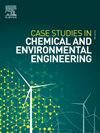Non-local piezoelasticity to incorporate the influence of small-scale factors on the resonance behavior of the Mindlin piezoelectric polymeric nanoplates
Q1 Environmental Science
Case Studies in Chemical and Environmental Engineering
Pub Date : 2025-01-30
DOI:10.1016/j.cscee.2025.101125
引用次数: 0
Abstract
This study presents an investigation into the vibration resonance of Mindlin piezoelectric polymeric nanoplates under electromechanical loading, particularly in the presence of a rotating nanoparticle. The novelty of this research lies in the application of non-local piezoelasticity, which effectively incorporates the influence of small-scale factors on the resonance behavior of the nanoplate. By employing a variational approach to derive the governing equations, this work advances the understanding of how various parameters such as the non-local parameter, dimensions of the nanoplate, excitation voltage, and mass of the nanoparticle affect resonance frequencies. The Galerkin method is utilized to solve the partial differential equations governing the dynamics of the piezoelectric polymeric nanoplate, marking a significant methodological contribution to the field. The incremental harmonic balance approach is then applied to estimate the system's resonance frequencies, with numerical simulations confirming their existence. This research not only elucidates the complex interactions affecting resonance behavior but also highlights the potential for optimizing the design of nanostructures in various applications, including sensors and energy-harvesting devices. The findings suggest that increasing the non-local parameter softens the nanoplate's rigidity, leading to decreased resonance frequencies, while modifications in dimensions and applied voltages can enhance these frequencies. Overall, this study lays the groundwork for future explorations into the dynamic behavior of piezoelectric materials, emphasizing the importance of small-scale effects in nanotechnology applications.
非局部压电弹性,以纳入小尺度因素对敏林压电聚合物纳米板共振行为的影响
本文研究了敏林压电聚合物纳米板在机电载荷下的振动共振,特别是在旋转纳米颗粒存在的情况下。本研究的新颖之处在于非局部压电弹性的应用,有效地结合了小尺度因素对纳米板共振行为的影响。通过采用变分方法推导控制方程,这项工作促进了对各种参数(如非局部参数、纳米板尺寸、激励电压和纳米颗粒质量)如何影响共振频率的理解。伽辽金方法用于求解控制压电聚合物纳米板动力学的偏微分方程,标志着该领域的重要方法贡献。然后应用增量谐波平衡方法来估计系统的谐振频率,并用数值模拟证实了它们的存在。这项研究不仅阐明了影响共振行为的复杂相互作用,而且强调了在各种应用中优化纳米结构设计的潜力,包括传感器和能量收集设备。研究结果表明,增加非局部参数会软化纳米板的刚度,导致共振频率降低,而改变尺寸和施加电压可以提高这些频率。总的来说,本研究为未来探索压电材料的动态行为奠定了基础,强调了纳米技术应用中小尺度效应的重要性。
本文章由计算机程序翻译,如有差异,请以英文原文为准。
求助全文
约1分钟内获得全文
求助全文
来源期刊

Case Studies in Chemical and Environmental Engineering
Engineering-Engineering (miscellaneous)
CiteScore
9.20
自引率
0.00%
发文量
103
审稿时长
40 days
 求助内容:
求助内容: 应助结果提醒方式:
应助结果提醒方式:


